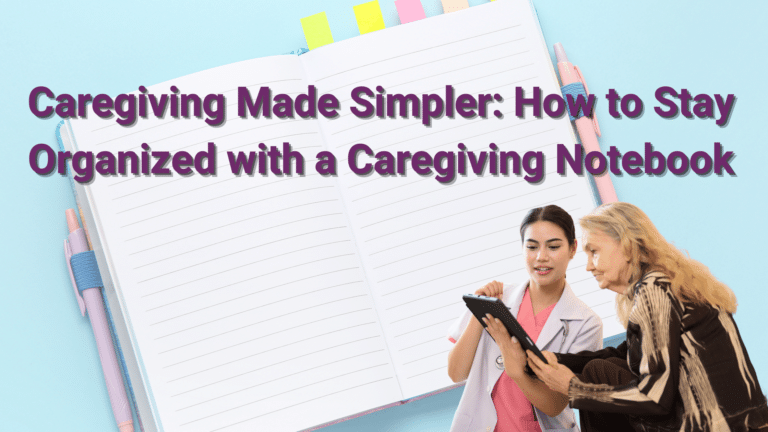Caregiving is challenging. Between managing medications, tracking appointments, and keeping up with daily tasks, it’s easy to feel overwhelmed. But staying organized can transform your caregiving experience.
Over the years, I’ve seen families navigate caregiving with varying levels of organization. Some relied on chaotic piles of sticky notes, while others used well-structured systems that made caregiving smoother. One tool consistently stood out: a caregiving notebook.
Let’s explore how a notebook can be your ultimate caregiving companion and how to set one up for success.
Why an Organized Caregiving System Matters
Caregiving often feels chaotic, but it doesn’t have to. By creating a simple caregiving notebook, you can:
- Save time during appointments.
- Reduce stress when emergencies arise.
- Track important patterns in your loved one’s health.
- Be prepared for any caregiving challenge.
5 Steps to Set Up Your Caregiving Notebook
1. Divide Your Notebook into Key Sections
Break your notebook into organized sections to ensure everything has its place:
- Medications: Record names, dosages, and side effects, as well as the prescribing doctor, date prescribed and reason given. This should be a significant part of your medication management plan.
- Appointments: Keep notes on visits and follow-ups. Include sheets of a calendar in this section.
- Daily Observations: Log moods, symptoms, and changes.
- Contacts: List doctors, pharmacists, and emergency numbers.
- Tasks and Reminders: Track errands and recurring caregiving tasks.
2. How to Use the Calendar Sheets for Scheduling
Include a calendar in your notebook to manage appointments, medication refills, and caregiving tasks. A visual schedule helps you stay one step ahead.
3. Create an Emergency Cheat Sheet
At the front of your notebook, create a quick reference page with:
- Emergency contact numbers
- Allergies
- Insurance details
- Key medical history
- A copy of your emergency plan should be included.
This page will save valuable time during high-stress moments.
4. Use Color Coding and Visual Aids
Color coding can make your notebook even more functional. For example, use red for urgent tasks and green for completed ones. Add sticky tabs to frequently used sections for quick access.
5. Leave Space for the Unexpected
Caregiving is unpredictable. Dedicate blank pages for notes on new symptoms, advice from healthcare providers, or changes to your routine.
Why Using a Caregiver Notebook for Organization Works
I once worked with a caregiver who was overwhelmed by her mother’s complex medical needs. By setting up a notebook with these steps, she regained control over her days and reduced her stress. She told me, “I finally feel like I can handle this.”
This system works because it reduces the mental load. You no longer have to remember every detail; the notebook does it for you.
Why Choose a Physical Notebook Over Digital Tools?
In an increasingly digital world, you might wonder: why use a physical caregiving notebook when there are countless apps and tools available? While digital tools can complement your system, a physical notebook offers unique advantages that make it indispensable for many caregivers.
1. Accessibility Without Limitations
A physical notebook is always ready to use. There are no passwords, internet connection, or charging cables required. Whether you are in a hospital waiting room, at a pharmacy, or sitting with your loved one at home, a notebook is accessible at all times.
I’ve seen the struggles of being in the middle of an emergency, scrambling to unlock your phone, and then realizing the app has timed out or there is no wi-fi or cell signal to connect to your service. A physical notebook bypasses all of these barriers, saving you precious time and effort.
2. A Tactile and Personalized Experience
Writing things down in a notebook creates a sense of connection and ownership. Studies show that handwriting notes can improve memory and help you process information better compared to typing.
One caregiver I met swore by her colorful notebook because she felt it was her “safe space.” She decorated it with stickers, used her favorite pens, and found comfort in flipping through pages filled with her own handwriting. This personalization is hard to replicate digitally.
3. A Reliable Backup During Technical Glitches
Technology, while convenient, is not foolproof. Phones die, apps crash, and files get corrupted. A physical notebook acts as a reliable backup. Even if your digital system is flawless, having a notebook ensures you are never left without critical information when something goes wrong.
4. Ease of Sharing Information
Sharing a physical notebook is often simpler than sharing a screen. Doctors, family members, and other caregivers can quickly flip through pages to find what they need, rather than scrolling through multiple app tabs or digital files.
I once saw a caregiver hand her notebook directly to a nurse during a doctor’s visit. The nurse found the exact medication information she needed within seconds, without asking for passwords or technical help.
5. The Mental Clarity of a Single Focus
Unlike digital tools, which can bombard you with notifications, a physical notebook creates a focused experience. When you open your notebook, your mind is on caregiving tasks, not on incoming emails or social media alerts.
How to Use a Physical Notebook with Digital Tools
While a physical notebook is invaluable, it does not mean you cannot use digital tools to complement your caregiving system. Here are some ways to combine the two:
- Calendar Syncing: Use a digital calendar to set appointment reminders but keep detailed notes in your notebook.
- Photo Storage: Snap photos of medical documents or prescriptions to store digitally, while summarizing key points in your notebook.
- Emergency Contact Backup: Keep a hard copy of contacts in your notebook but also have a digital list on your phone for quick sharing.
A Balanced Approach to Caregiving Organization
At the end of the day, caregiving organization is not one-size-fits-all. While some caregivers thrive with digital tools alone, others find the tactile nature of a notebook grounding and reliable. The best approach is often a combination of both, with a physical notebook serving as the foundation.
Start Your Caregiving Organization Today
Caregiving doesn’t have to feel overwhelming. By creating a caregiving notebook, you’ll save time, reduce stress, and feel prepared for whatever comes your way.
What organizational tips have worked for you as a caregiver? Share your insights in the comments below. Together, we can make caregiving a little bit easier for everyone.




